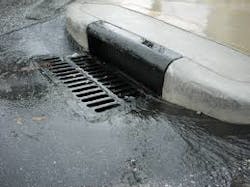Report says EPA should strengthen its permitting program for industrial management of stormwater
SOURCE: National Academies of Sciences, Engineering, and Medicine
WASHINGTON, DC, FEB 21, 2019 -- A new report from the National Academies of Sciences, Engineering, and Medicine offers guidance to the U.S. Environmental Protection Agency to inform the next revision of a permit program that requires industries to manage stormwater to minimize discharges of pollutants to the environment. The report, Improving the EPA Multi-Sector General Permit for Industrial Stormwater Discharges, recommends several ways that EPA can strengthen the Multi-Sector General Permit (MSGP) program to provide its intended environmental protection while balancing the overall burden of monitoring on industry.
"In general, the adoption of new knowledge into revisions of the MSGP program has been slow, but the program should not be a static enterprise," said Allen P. Davis, chair of the committee that wrote the report, and professor of civil and environmental engineering and Charles A. Irish Sr. Chair in Civil Engineering at the University of Maryland, College Park. "Both permitted facilities and the nation's waters would be best served by a progressive and continuously improving MSGP based on focused data-gathering efforts and analysis of new data, advances in industrial stormwater science and technology, and structured learning."
The MSGP is one of three permit programs under the Clean Water Act – the other two govern municipalities and construction sites -- used to regulate discharges of stormwater into local waters. Industrial stormwater is particularly challenging to control because of the wide range of industrial sectors that are included, each of which produces a unique set of contaminants in stormwater, the report notes.
Under the MSGP, industrial facilities must implement a self-certified stormwater pollution prevention plan, which includes implementation of control measures to reduce pollution levels. Many facilities must also monitor their stormwater discharge for specific pollutants, and the results are evaluated against benchmark thresholds – the concentrations above which EPA has determined represent a level of concern "that could potentially impair, or contribute to impairing, water quality or affect human health from ingestion of water or fish."
The report recommends that under the MSGP, EPA should require industry-wide monitoring for pH, total suspended solids (TSS), and chemical oxygen demand (COD) as basic indicators of the effectiveness of stormwater control measures employed on site. These parameters can serve as indicators of poor site management, insufficient stormwater control measures, or failures of these measures, which can lead to high concentrations of these and other pollutants. Industry-wide monitoring of these pollutants would also provide a baseline understanding of industrial stormwater management across all sectors.
The report recommends a tiered approach to monitoring that recognizes the varying levels of risk among different industrial activities and that balances the overall burden to industry and permitting agencies. Low-risk facilities could opt for a permit-term inspection by a certified inspector in lieu of monitoring. Those that do not qualify as low risk would conduct industry-wide monitoring for pH, TSS, and COD. Facilities in sectors that merit more pollution monitoring would also monitor for sector-specific benchmark parameters. Facilities that have repeatedly exceeded benchmarks, or large, complex sites with high potential for pollutant discharges would conduct more rigorous monitoring, potentially taking advantage of additional advanced monitoring and modeling strategies to assess the impacts of these sites.
Based on a review of several sectors, the report notes that benchmark monitoring requirements currently are not consistently applied; for example, in several sectors where stormwater pollutants are expected, little or no benchmark monitoring is required, while other sectors with similar industrial activities may have multiple benchmarks. Therefore, EPA should implement a process that uses new scientific information to periodically review and update sector-specific benchmark monitoring requirements. This process should consider updated industry fact sheets, published literature and industry data, advances in monitoring technology, and other available information, so that the monitoring programs adequately address the classes of pollutants used on site and their potential for environmental contamination.
The report offers a range of additional recommendations to improve the MSGP program. For example, it recommends that benchmark thresholds for pollutants be based on the latest toxicity criteria designed to protect aquatic ecosystems from adverse impacts from short-term or intermittent exposures, given the episodic nature of stormwater flow. It recommends that EPA suspend or remove the benchmarks for magnesium and iron until acute aquatic life criteria are established or benchmarks are developed based on long-term effects from intermittent exposures. It also recommends that EPA update and strengthen protocols, training, and data management tools for industrial stormwater monitoring, sampling, and analysis in order to improve the quality of monitoring data.
In addition, EPA should update the MSGP industrial sector classifications so that monitoring requirements extend to non-industrial facilities with activities and pollution risks similar to those currently covered, the report says. Many facilities generating pollutants of concern in stormwater, such as school bus transportation facilities and fuel storage and fueling facilities, currently are not included in the MSGP because they are not considered industrial. EPA should examine other facilities with activities similar to regulated facilities and include them in the MSGP so that pollutant risks from these sites can be appropriately reduced.
The study, conducted by the Committee on Improving the Next-Generation EPA Multi-Sector General Permit for Industrial Stormwater Discharges, was sponsored by the U.S. Environmental Protection Agency. The National Academies of Sciences, Engineering, and Medicine are private, nonprofit institutions that provide independent, objective analysis and advice to the nation to solve complex problems and inform public policy decisions related to science, technology, and medicine. The National Academies operate under an 1863 congressional charter to the National Academy of Sciences, signed by President Lincoln.
